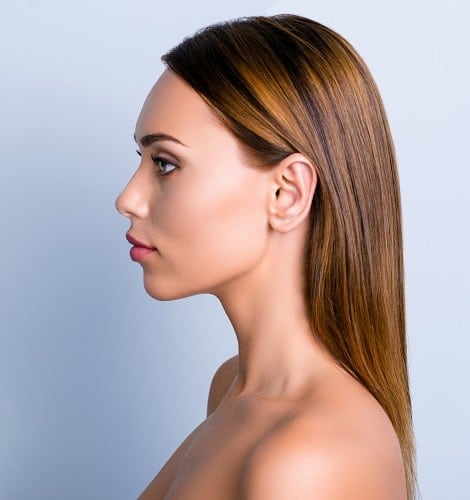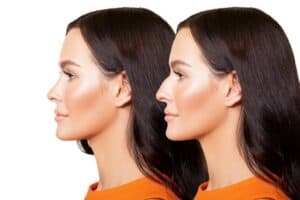Rhinoplasty in San Diego, CA
Personal Attention & Specialized Care
Rhinoplasty Procedure
It is a surgical procedure, commonly called a nose job or nose reshaping, that involves changing the proportions and shape of the nose. Therefore, the goal is to create facial balance and harmony and improving your overall appearance.
There are, however, many different reasons to undergo rhinoplasty, including a crooked nose, humped nose and wide nose Rhinoplasty can be performed as part of nose reconstruction to enhance shape and breathing. Moreover, it is also performed for congenital defects, cancer treatment and trauma.

Rhinoplasty recovery

Following your rhinoplasty, you will have your first postoperative visit within seven days to check for bleeding, and level of discomfort, and to answer any immediate concerns.
One week after surgery, the splint is removed. External sutures (if any) are removed. Despite swelling, the difference in the appearance of your nose is often immediately evident. At this time, you may resume normal, light daily activities. You may return to work 10-14 days after surgery. Most bruising is usually resolved by 2-3 weeks and swelling is reduced at this time. Vigorous activity (exercise, heavy lifting) is usually restricted until about six to eight weeks after surgery.
Contact sports can be resumed at 6-8 weeks after surgery. You may resume normal activities and exercising 6- 8 weeks after surgery. Any swelling will be significantly reduced at that point. Within eight to 12 months, most of the swelling will be gone. Any remaining swelling will disappear after one year.
Reasons for Nose surgery
Common reasons patients seek Dr. Jaibaji for nose surgery include:
- A hump on the bridge of the nose
- A wide bridge and /or a wide nasal tip
- Being able to see the nostrils too much
- Large or wide nostrils
- A crooked nose
- A “ski-jump” nose
- High or flared nostrils
Consultation
Before surgery, Dr. Jaibaji will evaluate your nose and look at many different factors, such as:
- Your general health and any medical problems
- Previous nasal injury, surgery or allergy
- How you breathe through your nose, and whether or not this needs to be addressed at the time of surgery, i.e., performing septal surgery
- The size and shape of each part of your nose (tip, bridge, nostrils, etc.) in relation to the other parts of your nose, i.e., is it proportional
- The size and shape of your nose relative to the rest of your facial features (your chin, lower jaw, etc.)
Rhinoplasty procedure details
The surgery is usually performed under general anesthesia as a same day surgery. Depending on the desired results and the complexity of your specific problem, the surgery may take anywhere from 1-3 hours.
The details of the specific type of nose surgery are suited to your specific aesthetic concerns and functional requirements and the placement of the incisions are determined will be discussed at length by Dr. Jaibaji during your first consultation.
There are, however, risks and complications with all surgical procedures such as bleeding and infection. Therefore, these as well as complications specific to rhinoplasty will be discussed at the time of your consultation.
Types of nose surgery
There are two surgical approaches to rhinoplasty: 1- Open rhinoplasty 2- Closed rhinoplasty. At Jaibaji Plastic Surgery, the open approach, however, is used most. It involves making an incision at the narrowest part of the columella and it is extended into the inside of the nose. The nose cartilages and bones are exposed very clearly and reshaped to provide the desired shape. After the surgery the incisions are closed with suture and a splint is applied.
Will I need cartilage graft?
In some rhinoplasty cases cartilage graft is needs. The graft is used to correct a deviation in the nose septum or to improve tip appearance. Dr. Jaibaji will discuss with you this option prior to surgery. The cartilage is usually taken from the nose septum. In some cases, ear cartilage or even rib cartilage is needed.
Do you perform septoplasty at the same surgery?
Yes. If septoplasty, reshaping and trimming of the septum, is needed it will be performed at the time of surgery. If the septum is deformed or displaced it will be reshaped and reattached to the correct position. Cartilage graft can be utilized to correct septal deviations and to improve the airway.
Rhinoplasty risks
Like any surgery, rhinoplasty surgery carries some risks. General risks include DVT and anesthesia complication. Local risks to the nose include bleeding, infection, persistent swelling, numbness of the nose tip, residual deformity and scarring. Pinched tip, hanging columella, breathing difficulty and residual dorsal bump are common causes for revision. During your consultation with Dr. Jaibaji the risks of surgery will be addressed.
Will I get a splint after surgery?
Yes. Most rhinoplasty cases will need a split applied to the back of the nose. The splint is usually removed after one week. In some cases, an internal splint is required. All the splints are applied during surgery and will be removed by Dr. Jaibaji. In some cases, splints are not allied such as tiplasty.
Rhinoplasty Cost?
The price includes the cost of facility, anesthesia and professional fees. For more complicated and involved procedures the cost will be higher. Financing is available at Jaibaji Plastic Surgery offices. After the consultation, pricing will be discussed with the patient.
Can I have another surgery with rhinoplasty?

- Chin surgery to highlight your new nose shape and minimize or increase a prominent or weak chin.
- Neck lift to remove submental fat (under the chin) and loose skin tissue. Neck lift reduces signs of aging and provides more jawline definition and a youthful neck contour.
- Eyelid surgery to address concerns with the upper and/or lower eyelids. Blepharoplasty reduces under-eye bags and puffiness and lifts sagging or drooping upper eyelids.
- Facial fat grafting to improve other areas of the face. Fat transfer improves flat or hollow cheeks and restores a youthful facial shape using fat harvested from another body area, such as the abdomen. Fat grafting can also fill in laugh lines, thinning lips and other lines and wrinkles. Cheek lift or facial implants may be other options for patients looking to improve their facial shape and profile.
- Brow lift to elevate drooping eyebrows and smoothen creases and lines along the forehead and between the brows.
- Liposuction to reduce unwanted fat. The removed fat may be used to fill in hollow areas of the face or increase buttock size. Neck liposuction eliminates a double chin for a better facial profile with a thinner jawline and highlights the improved nasal shape and size.
- Breast augmentation can also be performed in conjunction with rhinoplasty. If you’re unhappy with your natural breast size or struggle with volume loss due to age or childbearing, breast augmentation can provide your desired bust size so you can improve your nose concerns and reach your breast goals all at once.
- Breast reduction to decrease breast size. Many women struggle with overly large breasts that cause painful symptoms, such as back, neck and shoulder pain, deep bra strap indentions, skin chafing and infection. Breast reduction reduces the breasts to a size and shape that complements your figure and improves your quality of life. Men may also qualify for breast reduction to address gynecomastia.
Discuss your face and body goals with Dr. Jaibaji during your rhinoplasty consultation. He can determine if one of these complementary procedures can be combined with your nose surgery to reach several cosmetic goals simultaneously.
What is Rhinophyma?
Rhinophyma is a subtype of rosacea that affects the nose. Therefore, It makes the nose bigger, uneven and can obstruct breathing overtime. Moreover, It gives an unpleasant look.
It usually affects adults over the age of 40. In addition, It is more common in males with fair skin and have history of rosacea.
Are there other common names for rhinophyma?
Yes, It is commonly called drinker’s nose, sometimes referred to as Whisky nose or alcoholic nose. However, rhinophyma is a skin disorder and may not be related alcohol.
What is the treatment of Rhinophyma?
Surgery is the main treatment for rhinophyma. There are several surgical options: 1- Surgical excision with scalpel. 2- Dermabrasion. 3- Cryotherapy. 4- Laser treatment. The type of treatment will be determined during a consultation with Dr. Jaibaji.
Rhinoplasty FAQs
What is a Dorsal Hump?
The dorsum of the nose refers to the top of the nose. Normally, it is straight or has a gentle convexity towards a more projecting nasal tip. The dorsum of the nose may be satisfactory when viewed from the front, however, it may show too much projection when viewed from the side.
The nasal dorsum determines the character of the nose. Therefore, when the dorsum of the nose is concave or has a bump or a hump, this may interfere with the desired profile. In addition to the height and configuration of the nasal dorsum, the projection and shape of the nasal tip affects the nasal profile, and the contribution of both of these factors must be considered.
Moreover, the quality of the skin is especially important in nose surgery. Thick skin may not allow the altered anatomy to show through, whereas very thin skin may show any slight irregularity. When doing a nose reshaping surgery, a number of surgical techniques are available to reduce the dorsal hump to create better balance to the shape of the nose.
How is rhinoplasty different for females and males?

Rhinoplasty is a highly customized face procedure. While your sex doesn’t affect the surgical technique, your natural feminine or masculine attributes and cosmetic goals will play a role in Dr. Jaibaji’s surgical plan for your rhinoplasty.
Can a wide nasal tip be changed with rhinoplasty?
Another common concern with which rhinoplasty patients seek Dr. Jaibaji is a wide, bulbous or boxy tip. This is most often the result of heredity and may be partly a result of a thick nasal skin. Most patients seek refinement of the tip, and this must be carried out by the surgeon in such a manner as to maintain the natural appearance of the nose. A tip that is too pointy or small, particularly in proportion to the rest of the nose may result in an unnatural “operated on” appearance.
In patients with thin nasal skin, a wide tip is a consequence of large or splayed cartilages that form the tip.
In order to increase the precision of reshaping and resizing the tip, Dr. Jaibaji uses an “open approach” rhinoplasty technique. This method facilitates direct visualization of the nasal cartilages. It will, also, increases the predictability of the final surgical result. The open approach also allows for precise suturing of the nasal cartilages to reshape and refine them as well as position them more accurately.
Can a crooked or asymmetrical nose be corrected?
A nose may be crooked as a result of heredity, previous surgery, or trauma. It may be crooked in certain portions (tip, bridge, nostrils) or the entire nose may be asymmetrical.
Regardless of the cause, Dr. Jaibaji will determine the structural problem causing the asymmetry. It may be a cartilage problem (e.g., the septum), a bone problem, or a combination of both. The specific procedures to address the asymmetry will depend on these structural factors. Often, obstructed nasal breathing accompanies asymmetry of the nose, and these can be corrected using the techniques mentioned below.
The surgery may include cutting and repositioning the nasal bones (osteotomies), reshaping the nasal septum (septoplasty), septal extension, cartilage grafts and a variety of other techniques with which Dr. Jaibaji is familiar.
Before & After
View Our GallerySchedule a Rhinoplasty Consultation with Dr. Moneer Jaibaji
Schedule a consultation with Dr. Jaibaji to learn how rhinoplasty can benefit you. Call our San Diego or Coronado plastic surgery offices to inquire about an appointment.
Case Studies
This patient from San Diego was concerned about the bump on her nose. She underwent rhinoplasty ( nose Job) and the hump was removed. Her recovery was uneventful.
This patient from Orange County was interested in rhinoplasty. She was concerned about the high nose bridge, the wide and poorly defined tip and her nose tip points slightly down. She had a consultation with Dr. Jaibaji, double board certified plastic surgeon, at his San Diego office. The patients goals were to correct the hump, improve her tip shape and rotate the tip upward. The operation discussed was open rhinoplasty. In this procedure an incision is made in the narrowest part of the columella . This would allow complete visualization of the nose cartilages and allow to shape the cartilage to give her a better tip. At the same time, the dorsal hump was removed.
Gender: Female Facial Surgery San Diego Facial Procedure: Nose Job San Diego Smoking History: Non-Smoker Rhinoplasty Options: Open Rhinoplasty This patient, from San Diego, was concerned about the shape of her nose. She had a bump at the bridge and wide nose base. Images show before and after results.
This patient was concerned by the bump at the back of her nose. She also had trauma to the nose. She underwent removal of the bump and her recovery was uneventful.
Gender: Female, Height: 5′ 4″ Months Post-Op: 2 Facial Surgery Procedure: Rhinoplasty Smoking History: Non-Smoker Rhinoplasty Options: Open Rhinoplasty This patient had tip surgery, removal of the bump at the nose dorsum, and narrowing of the bones. Images are shown for the before and after.
Patient Age: 45 Patient Height: 5.2 Patient Weight: 112 This patient had silicone nasal implant to augment the nose bridge. The procedure was performed in the far east. Initially, she was pleased with the results, but, as the swelling started to subside she noticed deformity of the nose. The implant was shifted to the right side causing widening of the nose and was giving her constant pain. She saw Dr. Jaibaji for a consultation. After complete evaluation of her nose and her goals, she elected to have a nose revision surgery. During surgery, diced cartilage graft was used to replace the silicone implant. The silicone nose implant was removed.
This patient from San Diego had septal and nasal deviation. He underwent rhinoplasty to correct the septal deviation and removal of the bump at the back of the nose. Results are shown several months after surgery.
This patient had rhinopehyma, a condition of skin thickening of the nose and is related to rosacea. The excess skin was removed and the after pictures were taken 5 weeks after the surgery.
Revision rhinoplasty. Saddle nose deformity. This was corrected with placement of a diced cartilage graft to the nose dorsum.




